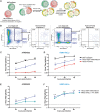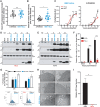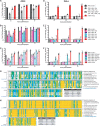Viral Determinants in H5N1 Influenza A Virus Enable Productive Infection of HeLa Cells
- PMID: 31776276
- PMCID: PMC6997754
- DOI: 10.1128/JVI.01410-19
Viral Determinants in H5N1 Influenza A Virus Enable Productive Infection of HeLa Cells
Abstract
Influenza A virus (IAV) is a human respiratory pathogen that causes yearly global epidemics, as well as sporadic pandemics due to human adaptation of pathogenic strains. Efficient replication of IAV in different species is, in part, dictated by its ability to exploit the genetic environment of the host cell. To investigate IAV tropism in human cells, we evaluated the replication of IAV strains in a diverse subset of epithelial cell lines. HeLa cells were refractory to the growth of human H1N1 and H3N2 viruses and low-pathogenic avian influenza (LPAI) viruses. Interestingly, a human isolate of the highly pathogenic avian influenza (HPAI) H5N1 virus successfully propagated in HeLa cells to levels comparable to those in a human lung cell line. Heterokaryon cells generated by fusion of HeLa and permissive cells supported H1N1 virus growth, suggesting the absence of a host factor(s) required for the replication of H1N1, but not H5N1, viruses in HeLa cells. The absence of this factor(s) was mapped to reduced nuclear import, replication, and translation, as well as deficient viral budding. Using reassortant H1N1:H5N1 viruses, we found that the combined introduction of nucleoprotein (NP) and hemagglutinin (HA) from an H5N1 virus was necessary and sufficient to enable H1N1 virus growth. Overall, this study suggests that the absence of one or more cellular factors in HeLa cells results in abortive replication of H1N1, H3N2, and LPAI viruses, which can be circumvented upon the introduction of H5N1 virus NP and HA. Further understanding of the molecular basis of this restriction will provide important insights into the virus-host interactions that underlie IAV pathogenesis and tropism.IMPORTANCE Many zoonotic avian influenza A viruses have successfully crossed the species barrier and caused mild to life-threatening disease in humans. While human-to-human transmission is limited, there is a risk that these zoonotic viruses may acquire adaptive mutations enabling them to propagate efficiently and cause devastating human pandemics. Therefore, it is important to identify viral determinants that provide these viruses with a replicative advantage in human cells. Here, we tested the growth of influenza A virus in a subset of human cell lines and found that abortive replication of H1N1 viruses in HeLa cells can be circumvented upon the introduction of H5N1 virus HA and NP. Overall, this work leverages the genetic diversity of multiple human cell lines to highlight viral determinants that could contribute to H5N1 virus pathogenesis and tropism.
Keywords: H5N1; HeLa; heterokaryon; highly pathogenic; influenza A virus.
Copyright © 2020 American Society for Microbiology.
Figures







References
-
- Palese P, Shaw ML. 2007. Orthomyxoviridae: the viruses and their replication, p 1647–1690. In Knipe DM, Howley PM, Griffin DE, Lamb RA, Martin MA, Roizman B, Straus SE (ed), Fields virology, 5th ed Lippincott Williams & Wilkins, Philadelphia, PA.
-
- CDC. 2019. Disease burden of influenza. https://www.cdc.gov/flu/about/burden/index.html.
Publication types
MeSH terms
Grants and funding
LinkOut - more resources
Full Text Sources
Medical
Molecular Biology Databases
Miscellaneous

